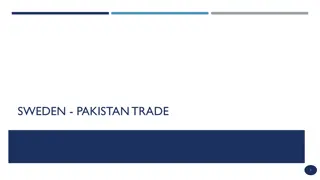Handbook on Integrating Business and Trade Statistics
The Handbook on Integrating Business and Trade Statistics aims to provide guidance on the integration of business and trade data to enhance policymaking and understanding the impact of globalization and international trade. It covers conceptual frameworks, methodological practices, and new indicators, targeting statisticians, policymakers, and stakeholders. Scheduled for completion in 2025, the Handbook is led by Ms. Ana Cristina Neves and Mr. Gerardo Durand, with contributions from experts in the field.
Download Presentation

Please find below an Image/Link to download the presentation.
The content on the website is provided AS IS for your information and personal use only. It may not be sold, licensed, or shared on other websites without obtaining consent from the author.If you encounter any issues during the download, it is possible that the publisher has removed the file from their server.
You are allowed to download the files provided on this website for personal or commercial use, subject to the condition that they are used lawfully. All files are the property of their respective owners.
The content on the website is provided AS IS for your information and personal use only. It may not be sold, licensed, or shared on other websites without obtaining consent from the author.
E N D
Presentation Transcript
Introduction of Handbook on Integrating Business and Trade Statistics Jiayue Zeng United Nations Statistics Division 1
I. BACKGROUND The UN Committee of Experts on Business and Trade Statistics (UNCEBTS) has identified the need to develop a Handbook on Integrating Business and Trade Statistics (HIBTS). 2 2
BACKGROUND Traditionally, business and trade statistics have been compiled and used separately. However, integrating business and trade data may provide useful information for policymaking, by considering the characteristics of enterprises involved in the trade of goods and services such as their economic sector, intra-firm trade, the size of the companies, interconnections of countries, the employment they generate, as well as the kind of goods and services traded, which are data of vital importance to know the impact of issues such as globalization and international trade on the national income, economic growth, and the impacts in society. The United Nations Committee of Experts on Business and Trade Statistics (UNCEBTS) has identified the need to develop a Handbook to provide guidance on integrating business and trade statistics. And that was welcomed in the 54th meeting of the United Nations Statistical Commission (UNSC). 3
BACKGROUND To provide a conceptual and methodological framework for integrating business and trade statistics, including national best practices, and to provide guidance for building and strengthening capacities on Micro Data Linking to compile these statistics in an internationally comparable manner. Moreover, it discusses some leading-edge topics such as gender and other social information, digital economy, and subnational statistics, as well as proposing new indicators based on mainstreaming business and trade. Goal of the Handbook: Mainly compilers and national accountants from National Statistical Offices (NSOs) or other statistical agencies in charge of producing business and trade statistics, with the aim to build and/or strengthen capacities for producing business and trade statistics. Policymakers and other stakeholders may also be interested in how these two domains are integrated. Target audience of the Handbook: 4
BACKGROUND The Handbook is scheduled to be completed and submitted to the 2025 UNSC for endorsement. Ms. Ana Cristina Neves and Mr. Gerardo Durand (of INE Portugal and INEGI Mexico respectively) are the chief editors of the Handbook. The roles of the team will be as follows: Chief editors: Will be responsible for organizing the activities, the meetings, and integrating the inputs from the contributors and circulating the integrated document to the reviewers; Integrate the inputs and feedback received from reviewers. Also, they will be in liaise with the secretariat (UNSD) and the TT-ITS to coordinate and present the Handbook progress. Contributors: Will be responsible for drafting the assigned chapter/section of the document. Reviewers: Will be responsible for revising the integrated document and providing feedback and orientation after each editing round. UNSD: Will provide administrative and technical support. 5
II. Handbook Content The Handbook on Integrating Business and Trade Statistics (HIBTS) provides foundations on the main concepts, data sources, and technical considerations for producing statistics by linking trade and business data. 6 6
III. Handbook Progress Important activities include iterative steps of drafting, reviewing, editing, endorsement by the UNCEBTS Bureau and global consultations. 8 8
Handbook Progress The Handbook is scheduled to be completed and submitted to the 2025 UNSC for endorsement. Q1-Q2.2024: Final edits by the TT- ITS and endorsement by UNCEBTS Bureau for the global consultation. Global consultation in Q2. H1.2023: Drafting/Editing 2023 2024 Q4.2024: UNCEBTS endorsement and submission to the UNSC H2.2023: Continuing drafting/editing 2023 2024 9 9
Handbook Progress Milestone Date Feb 2023 - May 2023 Jun 2023 1st editing round: Initial drafting and internal peer-reviewing; Discussion during the TT-ITS physical meeting in Jakarta 2nd editing round and peer-reviewing; Focus group meetings for each Chapter 3rd editing round and integration; Presentation of HIBTS progress during the TT-ITS meeting in Costa Rica Aug 2023 - Nov 2023 Nov 2023- Feb 2023 Dec 2023 Jan 2024 - Feb 2024 Mar 2024 - April 2024 May 2024 - July 2024 TT-ITS final review and endorsement by UNCEBTS Bureau 4th editing round and preparation of the global consultation Global Consultation Final drafting (5th editing round) and endorsement by the UNCEBTS Bureau Aug 2024 - Nov 2024 10
THANK YOU! Jiayue Zeng jiayue.zeng@un.org https://unstats.un.org/unsd/trade 11 11























